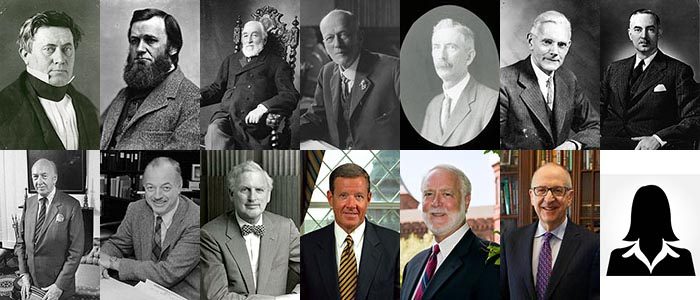Help wanted: Leader of the largest museum, education and research complex in the world
One of the most important jobs of the Smithsonian’s Board of Regents is finding and electing the Institution’s Secretaries. In late December, following the announcement of Secretary Skorton’s intended departure in June 2019, an e-mail from David Rubenstein, co-chair of the Regent’s Search Committee for a new Secretary, was sent to all staff about the search committee members and the search process.
Recently, Torch writer John Barrat sat down with Greg Bettwy, chief of staff in the Office of the Secretary, who is assisting the Regents with their search, to learn more about the process of finding a new leader for an Institution as large and complex as the Smithsonian.

Smithsonian Secretaries. Top row, from left, Joseph Henry (1846 – 1878); Spencer Fullerton Baird (1878 – 1887); Samuel Pierpont Langley (1887 – 1906); Charles Doolittle Walcott (1907 – 1927); Charles Greeley Abbot (1895 – 1928); Alexander Wetmore (1945 – 1954); Leonard Carmichael (1953 – 1964). Bottom row, S. Dillon Ripley (1964 – 1984); Robert McCormick Adams (1984 – 1994); I. Michael Heyman (1994 – 2000); Lawrence M. Small (2000 – 2007); G. Wayne Clough (2008 – 2014); David Skorton (2015 – 2019); TBD (2019 – )
How does the search for a new Secretary begin?
What we traditionally do first with searches at the director level and above is run a competitive process to find the right search firm. In one way every search is the same, you evaluate your candidates and get to a set of finalists. However, in other ways every search is different because you are looking at a different array of skill sets depending on what you need in that position at that time.
So you need to find the firm that has the best reach into the various markets in which you think you will find candidates, a firm that has the best team for you to work with, that has the best ability to understand the Smithsonian and represent us in the candidate pool, and sell us and the opportunity to candidates they know can succeed.
For the present search Heidrick & Struggles, one of the top 10 search firms in the nation, has been chosen. Denise Grant is one of this firm’s two co-leads in our search. She was heavily involved in the search that found David Skorton and has extensive knowledge of the Smithsonian. They are actively engaged in the marketplace now, and as one might expect, people are interested in the job of Secretary. The Smithsonian has a really nice resonance in the recruitment marketplace. Obviously, I can’t mention any candidate names.
The search firm engages in initial conversations with a large number of high-quality candidates. Next the regent’s search committee and Heidrick & Struggles work together to narrow that down to a set of people we meet for first-round interviews. Generally, a set of second-round interviews comes next and a finalist is presented to the Board of Regents. They then “elect” the next Secretary according to the bylaws—it is not a selection but an election by the full board.
What are the qualifications the Regents are seeking in a new Secretary?
We are looking for the main qualifications for most leaders: someone with vision and strategic thinking to position the Smithsonian to grow, someone with management acumen, and someone with a strong personal and organizational commitment to diversity, accessibility and inclusion. We want someone who has the ability to lead and manage in a decentralized organization where you have many centers of excellence—somebody who can lead centrally and permit excellence to happen locally.
We are also looking for a candidate who has the ability to navigate what can be a challenging congressional appropriations process and scrutiny of our budget. Someone who can manage through severe situations, such as another federal shutdown, for example; someone with the patience and knowledge to work with what can be a complicated federal process and help us stay the course even as we are buffeted by these external forces we can’t control.
Of course, diversity is a key part of our search, diversity in all of its facets: gender, race, ethnicity, age, geography, background, experience. I am 100 percent confident of a diverse pool of candidates.
Four of the last five secretaries led large universities. The odds would seem to indicate the next Secretary will come from higher education, as well.
The complexity of managing a large national-scale university has many analogues to the Smithsonian, but higher education is not the only sector being investigated.
A leader in the cultural non-profit landscape would have many of the skill sets we are looking for. The federal public sector market also can produce candidates that have experience in managing large national-scale, multi-tiered, complex organizations.
Qualified leaders might also arise from corporate America—leaders who have the skills and passion for public service and for what the Smithsonian does. Obviously, people with multi-sector experience would be very attractive to us, because the Smithsonian isn’t just, for instance, a revenue-generating place and we aren’t just a non-profit, we have all of these pieces and more.
Someone with multi-sector experience who understands the blending of an organization like this would be a very attractive candidate. We are looking everywhere.
Is a background of successful fundraising THE most important qualification?
An ability to engage donors, steward them and cultivate them to support the Institution’s goals is certainly critical. Obviously, many of the places candidates are coming from may not have the same scale and scope for fundraising that the Smithsonian does, yet past employment that illustrates a strong capacity for fundraising is a good indicator.
Fundraising is definitely a skill set needed to succeed as Secretary.
Would a candidate who is a Smithsonian employee be considered?
Yes. This is a wide-open search and that includes our own talent. Smithsonian staff who have deep backgrounds in museums and in research would obviously have many of the skill sets we are looking for in a Secretary.
What is the length of time candidates are being asked to commit?
It would be great to have someone commit for five to 10 years as Secretary, but we recognize circumstances change and not everybody is able to stay that long.
Museums have seen more churn in top positions in the last decade. Directors just don’t stay in their jobs 30 years anymore. It is normal now to see more turnover than we once did. It is easier to find opportunities today as the museum field and adjacent fields expand. People move jobs more today—not just in the museum field, but everywhere.
This job isn’t for everybody and that is part of the reason we have intense discussions with potential candidates. We want candidates who know what they are getting into and who have the skill sets and energy for the job.
Although the nature of the work of the Secretary is changing, the Smithsonian still has this ability to attract great people and keep them. In general, a leader who can commit to between five and 10 years is someone the Regents are looking for, but we know that isn’t something everyone can commit to.
Would you consider a candidate from a tech company like Facebook or Google?
One of the skill sets we hope to find in a high-performing candidate is a fluency in technology and an understanding of how it can advance the Smithsonian’s mission to help build internal and external communities.
Technology underpins many of the goals of our strategic plan. If we are going to reach new audiences, we are not only going to need more content, but also share it in new ways. Technology is key to that. Technology not only underpins world-class research and scholarship, as well as our global outreach, but also IT infrastructure is one of the core resources for everything we do.
A third critical way technology affects us is how we use it to improve our administrative operations. Many aspects of our administration can be improved by how we use technology and leverage it.
Is there a job announcement for the Secretary’s job?
A job announcement per se, no, but there is a job specification that we share with candidates and which starts the conversation.
If someone is referred to the Board, we have the search firm reach out; part of that is sharing this job specification. The specification lays out what the Secretary’s job duties are, explains the Smithsonian on a broad level and helps start a conversation with a candidate about what we are looking for and lays out the experiences and skills we think are important.
Through these initial conversations, we engage and cultivate high-performing candidates, share more about the job with them and answer their questions. These initial dialogues help the search firm understand candidates and help candidates understand us, ultimately leading to interviews with the top performers.
How obligated will the new Secretary be to following the Smithsonian’s Strategic Plan?
The Board of Regents and Smithsonian’s senior leadership are all moving forward with the strategic plan. The new Secretary will have the ability to shape specific milestone projects, tasks, metrics, etc. that show how we complete those plans.
The new Secretary doesn’t have to start from scratch, nor be presented with things that are fully baked with no chance for input. The new person will have a great opportunity to shape directions and paths within the framework of the strategic plan.
We want people who understand the challenge and are willing to take it on and have the skill sets to manage our complexity and take us to new levels. There are many of those people out there in many different sectors and we’re going to find them.
So, how is it going?
Right now, all indications are that we are moving forward and on time for a selection in July. A start date depends on the candidate and I cannot predict that date right now. The search committee is committed to finding a person by July and then we will negotiate a start date based on that person’s availability.
Are the Regents seeking any guidance in their search from Smithsonian staff?
Absolutely. There are several ways that we are getting stakeholder input into this search. When developing the position specification we reach out to unit representatives, such as museum directors, and ask, ‘What do you think? What things are missing that we should have?’ This helps shape the specification.

Greg Bettwy (Photo by John Barrat)
Then, during the search, if the search committee needs do a gut check or has questions, we again reach out to stakeholder groups for their advice. As we go through interviews, we use the museum directors on the search committee as sounding boards not only for their personal opinions but also to ask how do you think other directors might react? This stakeholder participation is part of the process itself. Any suggestions about the search can be directed to me at BettwyG@si.edu.
For director-level searches, we have finalists interview with staff, peer directors, Castle administrators, etc. At the Secretary level we aren’t able to do this because candidates are understandably, extremely concerned about confidentiality. Obviously, if a candidate’s organization learned that a top-level person was thinking of leaving, it could have serious repercussions for the candidate and the organization.
Confidentiality is critical.
Is there anything else you’d like to share?
Yes. One question I hear frequently is, ‘How does the search for a new Secretary intersect with the search for a new Under Secretary for Finance and Administration/Chief Financial Officer—Al Horvath’s former position?’.
The answer is we are working through the process to have a long list of candidates in advance to make sure that the new Secretary is comfortable with the candidate pool, enabling a selection soon after he or she arrives. This way they won’t have to start from scratch and wait through a search period before deciding on a thoroughly vetted candidate for this important position.
Posted: 15 April 2019
- Categories:




